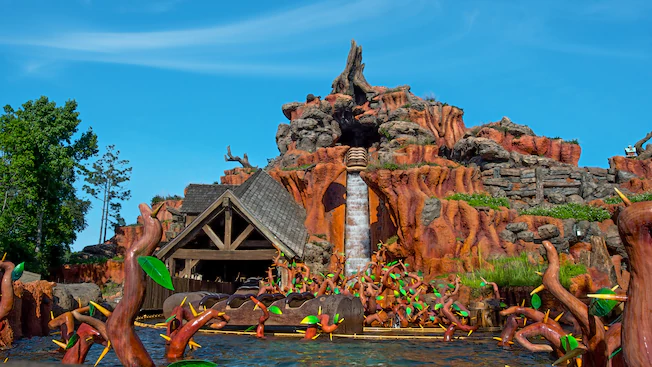My first night managing Splash Mountain was … interesting.

Splash Mountain in the Magic Kingdom Park at the Walt Disney World Resort
I had just joined the park management team two weeks prior. For the past several years, I had worked in operations learning and development, designing and facilitating training programs across the Walt Disney World Resort. However, as part of a management shake up, the L&D function was significantly reduced. While most of my team was let go, I moved into park operations—specifically the busiest corner of the busiest theme park in the world. I then had two weeks to train on all of the area attractions, including Big Thunder Mountain Railroad (roller coaster), Tom Sawyer Island (free-floating rafts), Country Bear Jamboree (southern bears) and, of course, Splash Mountain (the most popular ride in the park).
This limited schedule, combined with the upcoming Easter holiday, meant that I didn’t have a chance to do much additional training. Sure, I had worked in park operations for years prior, but this was a new area with new stakes, and a new set of “what if” situations. “What if” situations are almost always dependent on a manager’s experience and tacit knowledge. I had never managed a location with this volume, scale, or complexity before. So, while I knew how to be a Disney manager and focus on critical considerations like safety, customer service, and efficiency, I had yet to experience the specific challenges this role could bring. This is why the first night became so interesting and so important in my professional development.
Things went sideways almost immediately when I arrived that night. To be clear, no one was at fault. It was just the technical nature of theme park attractions. We began to experience disruptions that caused delays, in-show exits, and ultimately the closure of the attraction for the evening (along with me making a phone call to an executive to explain why I had lost the busiest ride in their park for several hours). While I knew exactly how to handle the guest side of the problem, I was not yet fully versed on the technical and procedural components of this world. Therefore, I had to lean hard on the cast members to get the job done. That night, the majority of the people in the mountain were college interns who had been in their roles for less than 6 months. But, in the toughest of circumstances, they performed exceptionally. Why? After all, this was not a normal evening in the Magic Kingdom. Despite their limited tenure, my team was ready for the “what if.”
The Importance of “What If”
We spend the bulk of our training time focused on the normal stuff—how we expect things to operate day-to-day. And that makes sense. However, we often glaze over or completely forget the other side of business—the times when things go inevitably wrong. These are the make-or-break moments for any organization. We have an opportunity to show our customers just how agile and resilient we are as a team as well as how much we care about their experience. We can often rely on our experienced employees to get us through these moments thanks to their tacit knowledge, but these people won’t always be around to save us. They certainly weren’t there that night at Splash Mountain.
So how do you prepare for “what if” without losing focus on the regular day-to-day?
Onboarding
“What if” moments should definitely be a component of the onboarding experience. However, because this knowledge is unlikely to be applied in an employee’s early days on the job, it should not overwhelm their training agenda. Rather, “what if” moments should be explored for awareness to help the employee understand what could happen in the future and how their resources, including peers and managers, can be leveraged to overcome the problem. If a “what if” moment occurs during the employee’s onboarding, the trainer should make sure to include the employee in the discussion to provide exposure in context rather than relying on simulation or discussion alone. In my case, new cast members were regularly brought into the downtime procedure at the attraction despite their inability to play an active role. This paid major dividends when I needed them months later.
Reinforcement
Because “what ifs” are not likely required knowledge to get an employee started in their role, reinforcement is a critical part of their overall learning experience. Once they are settled on the job, refresher activities should be layered into their experience so that, when a “what if” occurs, they have the knowledge and confidence necessary to act. As a Disney manager, an important part of my role was providing reinforcement on critical topics, including safety and customer service, to the cast. For example, I conducted daily huddle conversations with the team and addressed specific topics based on the current needs of the operation. Rather than just tell people what to do, I asked questions and drew the information out of the group. In addition, I regularly approached cast members while on the job and asked them a quick set of targeted questions to make sure they could immediately recall important knowledge. For example, I would drill the team on what to do if they heard a strange noise (stop ride motion). These simple reinforcement activities made me confident that my team would be ready when a “what if” moment occurred, and they certainly were that night.
Resources
It takes time to build up the knowledge and experience necessary to perform under pressure. Therefore, simple, on-demand resources are another essential part of preparing for “what if.” Employees who do not explicitly know how to handle a situation should definitely know where to find help in the moment of need. This can take many forms, from an online help tool to a printed job aid. I benefited greatly from this type of on-demand performance support that night. During my training, another manager had provided with me a set of directions for navigating the paths throughout Splash Mountain that I could access on my Blackberry. This was critical in helping me find my way (literally) during my first night.
Coaching
We can always do better. Training and resources can help us comprehend the basics, but coaching is a much more timely and contextual means of improvement. This is especially true after a “what if” moment. Success should definitely be celebrated, but opportunities for continued learning must also be identified. This is where frontline managers play an especially critical role in workplace learning, as the L&D team will likely not be there for the “what if” moments. The manager must assess how an employee handled the situation and address any opportunities for improvement. This should be done quickly and through discussion, not just direction. The entire situation should be explored so that the full context is applied as part of the coaching experience. In my case, I broke down the events of my first night with several peers to get their insight into how I could have done better. Needless to say, my future Magic Kingdom “what ifs” were much easier to overcome.
My first night managing Splash Mountain not only grew my respect for the cast members, but it also reinforced the importance of preparing for the “what ifs.” This focus continued throughout my time at Disney and now into my L&D work. Be sure to challenge your team, including operational partners, on how they are preparing your organization for the inevitable “what ifs” in your business. They probably won’t involve a talking rabbit, but they’re still out there.


